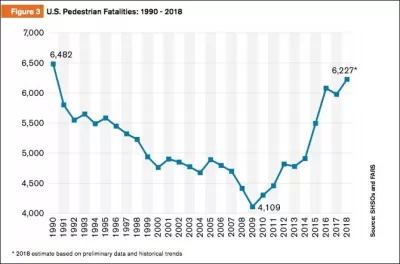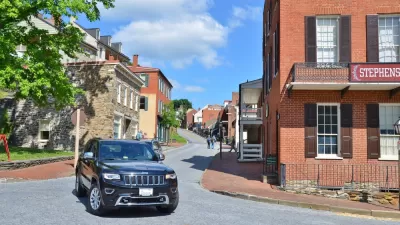Europe proves to Americans that when it comes to pedestrian fatalities, it doesn't have to be this way.

Joe Cortright takes a deep dive into the latest traffic safety data provided by the National Highway Traffic Safety Administration.
The most alarming data from the latest traffic safety report, as summarized by Cortright, "In the nine years from 2009 and 2018, pedestrian deaths increaseed 51 percent from 4,109 to 6,227."
Cortright's larger point isn't to prove exactly why so many more cars are killing so many more pedestrians on streets and roads around the country, but that Americans should not accept these tragedies as a necessary result of mobility. Americans only need look to Europe, which has greatly reduced pedestrian fatalities over the same span.
While some may regard a pedestrian death toll as somehow unavoidable, the recent experience of European countries as a group suggests that there’s nothing about modern life (Europeans have high rates of car ownership and as many smart phones as Americans) that means the pedestrian death toll must be high and rising. In fact, at the same time pedestrian deaths have been soaring the US, they’ve been dropping steadily in Europe. In the latest nine year period for which European data are available, pedestrian deaths decreased from 8,342 to 5,320, a decline of 36 percent.
Those data come from the European Road Safety Observatory [pdf].
Aaron Short at Streetsblog USA first reported on the pedestrian safety data from the NHTSA.
FULL STORY: Why are US drivers killing so many pedestrians?

Study: Maui’s Plan to Convert Vacation Rentals to Long-Term Housing Could Cause Nearly $1 Billion Economic Loss
The plan would reduce visitor accommodation by 25,% resulting in 1,900 jobs lost.

North Texas Transit Leaders Tout Benefits of TOD for Growing Region
At a summit focused on transit-oriented development, policymakers discussed how North Texas’ expanded light rail system can serve as a tool for economic growth.

Why Should We Subsidize Public Transportation?
Many public transit agencies face financial stress due to rising costs, declining fare revenue, and declining subsidies. Transit advocates must provide a strong business case for increasing public transit funding.

How to Make US Trains Faster
Changes to boarding platforms and a switch to electric trains could improve U.S. passenger rail service without the added cost of high-speed rail.

Columbia’s Revitalized ‘Loop’ Is a Hub for Local Entrepreneurs
A focus on small businesses is helping a commercial corridor in Columbia, Missouri thrive.

Invasive Insect Threatens Minnesota’s Ash Forests
The Emerald Ash Borer is a rapidly spreading invasive pest threatening Minnesota’s ash trees, and homeowners are encouraged to plant diverse replacement species, avoid moving ash firewood, and monitor for signs of infestation.
Urban Design for Planners 1: Software Tools
This six-course series explores essential urban design concepts using open source software and equips planners with the tools they need to participate fully in the urban design process.
Planning for Universal Design
Learn the tools for implementing Universal Design in planning regulations.
City of Santa Clarita
Ascent Environmental
Institute for Housing and Urban Development Studies (IHS)
City of Grandview
Harvard GSD Executive Education
Toledo-Lucas County Plan Commissions
Salt Lake City
NYU Wagner Graduate School of Public Service





























